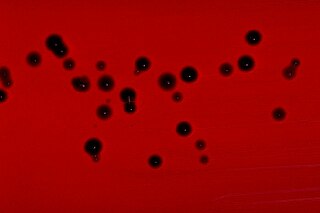
Kikuchi disease was described in 1972 in Japan. It is also known as histiocytic necrotizing lymphadenitis, Kikuchi necrotizing lymphadenitis, phagocytic necrotizing lymphadenitis, subacute necrotizing lymphadenitis, and necrotizing lymphadenitis. Kikuchi disease occurs sporadically in people with no family history of the condition.
Multilocus sequence typing (MLST) is a technique in molecular biology for the typing of multiple loci, using DNA sequences of internal fragments of multiple housekeeping genes to characterize isolates of microbial species.
Bartonellosis is an infectious disease produced by bacteria of the genus Bartonella. Bartonella species cause diseases such as Carrión's disease, trench fever, cat-scratch disease, bacillary angiomatosis, peliosis hepatis, chronic bacteremia, endocarditis, chronic lymphadenopathy, and neurological disorders.

Chromobacterium violaceum is a Gram-negative, facultative anaerobic, non-sporing coccobacillus. It is motile with the help of a single flagellum which is located at the pole of the coccobacillus. Usually, there are one or two more lateral flagella as well. It is part of the normal flora of water and soil of tropical and sub-tropical regions of the world. It produces a natural antibiotic called violacein, which may be useful for the treatment of colon and other cancers. It grows readily on nutrient agar, producing distinctive smooth low convex colonies with a dark violet metallic sheen. Some strains of the bacteria which do not produce this pigment have also been reported. It has the ability to break down tarballs.
Mycobacterium farcinogenes is a species of the phylum Actinomycetota, belonging to the genus Mycobacterium.
Mycobacterium florentinum is a strain of bacteria found in humans that can cause infections and other disease conditions, and prolong sickness. It presents a high resistance to antimycobacterial drugs. It is characterized by: slow growth and a short helix 18 in the 16S rDNA.
Mycobacterium gordonae is a species of Mycobacterium named for Ruth E. Gordon. It is a species of the phylum Actinomycetota, belonging to the genus Mycobacterium.
Mycobacterium hassiacum is a rapid-growing thermophilic mycobacterium that was isolated in human urine in 1997 by researchers at the German University of Regensburg. It's a species of the phylum Actinomycetota, belonging to the genus Mycobacterium.
Mycobacterium heidelbergense is a Gram-positive, nonmotile, acid-fast coccobacillus. It is a species of the phylum Actinomycetota, belonging to the genus Mycobacterium.
Mycobacterium interjectum is a species of the phylum Actinomycetota, belonging to the genus Mycobacterium.
Mycobacterium avium complex is a group of mycobacteria comprising Mycobacterium intracellulare and Mycobacterium avium that are commonly grouped because they infect humans together; this group, in turn, is part of the group of nontuberculous mycobacteria. These bacteria cause Mycobacterium avium-intracellulare infections or Mycobacterium avium complex infections in humans. These bacteria are common and are found in fresh and salt water, in household dust and in soil. MAC bacteria usually cause infection in those who are immunocompromised or those with severe lung disease.

Mycobacterium kansasii is a bacterium in the Mycobacterium genus. It is an environmental bacteria that causes opportunistic infections in humans, and is the one of the leading mycobacterial causes of human disease after tuberculosis and leprosy.

Mycobacterium lentiflavum
Etymology: Lentus from Latin for slow, flavus, Latin for yellow.
Mycobacterium malmoense is a Gram-positive bacterium from the genus Mycobacterium.
Mycobacterium senegalense is a species of Mycobacterium.

Proteus penneri is a Gram-negative, facultatively anaerobic, rod-shaped bacterium. It is an invasive pathogen and a cause of nosocomial infections of the urinary tract or open wounds. Pathogens have been isolated mainly from the urine of patients with abnormalities in the urinary tract, and from stool. P. penneri strains are naturally resistant to numerous antibiotics, including penicillin G, amoxicillin, cephalosporins, oxacillin, and most macrolides, but are naturally sensitive to aminoglycosides, carbapenems, aztreonam, quinolones, sulphamethoxazole, and co-trimoxazole. Isolates of P. penneri have been found to be multiple drug-resistant (MDR) with resistance to six to eight drugs. β-lactamase production has also been identified in some isolates.
Mycobacteroides is a genus of Gram-Positive rod-shaped bacteria in the family Mycobacteriaceae from the order Mycobacteriales.
Mycolicibacter heraklionensis is a species of bacteria from the phylum Actinomycetota. It is susceptible to clarithromycin. It is known to cause tenosynovitis in humans, but has also been isolated from sputum, urine, and a soft-tissue ankle mass.
"Mycolicibacter virginiensis" is a species of bacteria from the phylum Actinomycetota. It is susceptible to clarithromycin, ethambutol, rifabutin, and TMP-SMX. It has been isolated from cases of tenosynovitis, swine farm mud, bovine feces, sputum, and diseased dromedaries.




